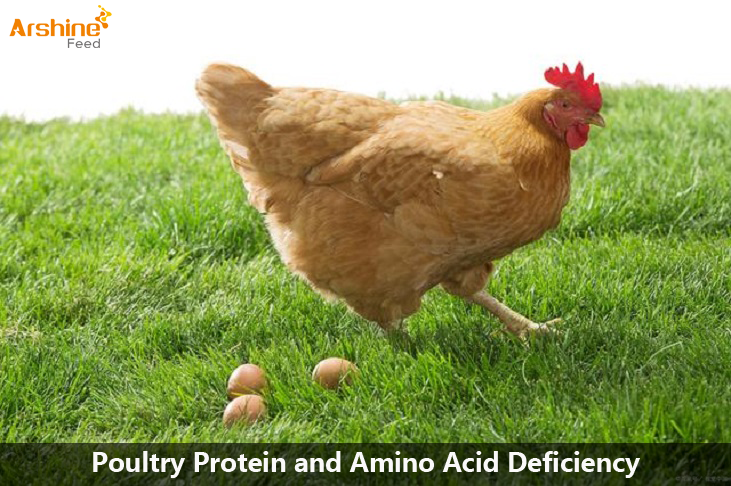

Poultry protein and amino acid deficiency refers to the condition where poultry intake of protein is insufficient or their consumption is excessive, leading to a deficiency in one or more amino acids.
Insufficient Protein and Amino Acids in Feed: There is a significant variation in the protein and amino acid content in commonly used poultry feeds. Cereal grains and bran feeds have low protein content and incomplete nutritional value, especially lacking methionine and lysine. In contrast, animal protein feeds have higher protein content and more complete amino acid profiles. If the feed types are single, the diet composition is unreasonable, or there is a long-term lack of animal protein feed, protein and amino acid deficiencies can occur. Additionally, the requirement for protein and amino acids in poultry is closely related to their type, breed, age, production performance, environmental temperature, and dietary energy levels. For instance, broiler chicks and breeder chicks need the most protein and amino acids during the brooding stage, which gradually decreases as the chicks grow. Meat-type poultry require more than egg-type poultry; growing poultry need more than adults; laying hens need more from the start of laying to peak production, decreasing with declining egg production. High temperatures reduce feed intake, necessitating an increase in protein content in the feed. High dietary energy levels lead poultry to reduce their feed intake, requiring higher protein and amino acid content in the feed. Ignoring these factors in poultry feeding can lead to protein and amino acid deficiencies when using a fixed formula for a long time.
Imbalanced Amino Acid Composition: Insufficient feed protein inevitably leads to a deficiency and imbalance in amino acids. Even a deficiency in one amino acid can affect the utilization of other amino acids, causing multiple amino acid deficiencies. Essential amino acids like lysine, methionine, and tryptophan limit the use of other amino acids in protein synthesis. Feeding poultry with feeds low in these amino acids (e.g., corn and sorghum grains, bran feeds) over the long term can cause deficiencies in other amino acids. Additionally, certain amino acids have special relationships; for example, tyrosine and cystine can be converted from phenylalanine and methionine in poultry bodies. When the former two are deficient, the requirement for the latter two increases, leading to deficiencies in phenylalanine and methionine. Although glycine can be synthesized in the poultry body, it synthesizes slowly in chicks, not meeting their rapid growth needs, leading to deficiencies if not supplemented in their diet. Inadequate consideration of antagonistic and conversion relationships between certain amino acids can also cause deficiencies.
Disease-Induced Decreased Feed Intake: Diseases can reduce feed intake, leading to insufficient protein intake. Diseases like avian pasteurellosis, coccidiosis, digestive tract inflammation, and digestive dysfunction can affect the digestion, absorption, and utilization of protein in poultry. Certain febrile diseases and chronic wasting diseases, such as avian tuberculosis, Marek's disease, avian leukemia, and digestive tract nematode infections, increase protein consumption in poultry. Insufficient carbohydrates and fats in the diet can strengthen protein decomposition and affect protein synthesis.
Proteins are the material basis of life, comprising the main components of poultry body cells and eggs, including muscles, skin, feathers, nerves, internal organs, enzymes, hormones, antibodies, and more, participating in metabolic activities. Thus, proteins and amino acids are crucial for maintaining life, growth, development, genetics, disease resistance, and egg formation in poultry. Protein and amino acid deficiencies can disrupt metabolism, causing growth inhibition, reduced productivity, and lowered disease resistance.
Chicks with protein and amino acid deficiencies exhibit slow growth and development, disordered and dull feathers, weakness, lethargy, poor appetite, slightly low body temperature, and frequent clustering. Plasma colloid osmotic pressure decreases, leading to subcutaneous edema, reduced total red blood cell count, and hemoglobin, causing anemia and failure to reach expected weight gain.
Adult poultry show progressive emaciation, reduced or ceased egg production; male poultry exhibit poor sperm motility, low fertilization rates, and low hatchability.
Regardless of age, deficient poultry have reduced albumin and globulin in the blood, leading to poor disease resistance and susceptibility to secondary infections, often resulting in death.
Post-mortem examination reveals that most deficient poultry are emaciated, with disappeared subcutaneous fat, edema, pale and atrophied muscles, thin and poorly coagulated blood, fluid accumulation in thoracic, abdominal cavities, and pericardium, almost no body fat, and coronary fat of the heart appearing gelatinous.
Diagnosis is typically based on clinical symptoms (slow growth, emaciation, anemia, reduced productivity) and pathological changes (disappeared fat, muscle atrophy, edema, fluid accumulation), combined with feed analysis. Additionally, significant decreases in blood total protein, albumin, globulin, total red blood cells, and hemoglobin can assist in diagnosis if necessary.
Ensure Adequate Protein in Poultry Diets: When formulating poultry diets, consider energy, vitamins, and minerals, with protein being a crucial factor. Generally, grains and bran have low protein content and incomplete nutritional value. Hence, balance plant and animal protein feeds (e.g., soybean meal, cottonseed meal, rapeseed meal, fish meal, blood meal, meat and bone meal). For chicks and broilers, the protein feed content should be about 20%; for laying hens, 14%-16%, with animal protein feed not less than 3%.
Maintain Amino Acid Balance and Antagonistic Relationships: Deficiency in limiting amino acids affects the utilization of other amino acids. Therefore, supplement the diet with feeds and additives rich in these amino acids. Pay attention to antagonistic effects between certain amino acids, such as arginine and lysine, valine, leucine, and isoleucine, adjusting all amino acids in a group when increasing one or two to avoid deficiencies.
Timely Adjustment of Feed Formulas: Determine protein and amino acid requirements based on poultry type, breed, age, productivity, environmental temperature, and dietary energy levels, adjusting the feed formula accordingly, rather than using a fixed formula long-term.
Attention to Feed Processing: Ensure protein quality in feed. Poor quality protein lacks essential amino acids or has low levels. For example, high-temperature processing of soybeans can reduce lysine and arginine activity, and damage cystine, lowering the protein nutritional value.
Add: Block 14, No.100, Luyun Road,Changsha 410205,China.
Mobile: +86 18874001228
Email: info@arshinefeed.com
WhatsApp: 8618874001228
WeChat: weiyuyan91